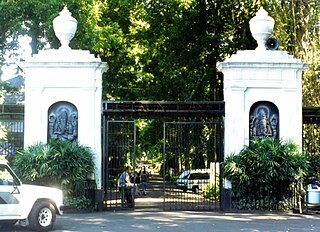Related Research Articles

The Fabaceae or Leguminosae, commonly known as the legume, pea, or bean family, are a large and economically important family of flowering plants. It includes trees, shrubs, and perennial or annual herbaceous plants, which are easily recognized by their fruit (legume) and their compound, stipulate leaves. Many legumes have characteristic flowers and fruits. The family is widely distributed, and is the third-largest land plant family in number of species, behind only the Orchidaceae and Asteraceae, with about 765 genera and nearly 20,000 known species.

In botany and dendrology, a rhizome is a modified subterranean plant stem that sends out roots and shoots from its nodes. Rhizomes are also called creeping rootstalks or just rootstalks. Rhizomes develop from axillary buds and grow horizontally. The rhizome also retains the ability to allow new shoots to grow upwards.

This article relates to the flora of New Zealand, especially indigenous strains. New Zealand's geographical isolation has meant the country has developed a unique variety of native flora. However, human migration has led to the importation of many other plants as well as widespread damage to the indigenous flora, especially after the advent of European colonisation, due to the combined efforts of farmers and specialised societies dedicated to importing European plants & animals.

Comptonia peregrina is a species of flowering plant in the family Myricaceae. It is the only extant (living) species in the genus Comptonia, although a number of extinct species are placed in the genus. Comptonia peregrina is native to eastern North America, from southern Quebec, east to Nova Scotia, south to the extreme north of Georgia, and west to Minnesota. The common name is sweetfern or sweet-fern, or in Quebec, comptonie voyageuse.

Acacia, commonly known as the wattles or acacias, is a large genus of shrubs and trees in the subfamily Mimosoideae of the pea family Fabaceae. Initially, it comprised a group of plant species native to Africa and Australasia, but it has now been limited to contain only the Australasian species. The genus name is New Latin, borrowed from the Greek ἀκακία, a term used by Dioscorides for a preparation extracted from the leaves and fruit pods of Vachellia nilotica, the original type of the genus. In his Pinax (1623), Gaspard Bauhin mentioned the Greek ἀκακία from Dioscorides as the origin of the Latin name.

The Bogor Botanical Gardens is a botanical garden located in Bogor, Indonesia, 60 km south of central Jakarta. It is currently operated by Indonesian Institute of Sciences. The Garden is located in the city center and adjoin the presidential palace compound of Istana Bogor. It covers an area of 87 hectares and contains 13,983 different kinds of trees and plants of various origin. The geographic position of Bogor means it rains almost daily, even in the dry season. This makes the Garden an advantageous location for the cultivation of tropical plants.

"Jawaharlal Nehru Tropical Botanic Garden and Research Institute", renamed in the fond memory of visionary Prime Minister of India Shri Pandit Jawaharlal Nehru is an autonomous Institute established by the Government of Kerala on 17 November 1979 at Thiruvananthapuram, the capital city of Kerala. It functions under the umbrella of the Kerala State Council for Science, Technology and Environment (KSCSTE), Government of Kerala. The Royal Botanic Gardens (RBG), Kew played an exemplary and significant role in shaping and designing the lay out of the JNTBGRI garden in its formative stages.

Senegalia rugata, commonly known in India as Shikakai, is a spiny climbing shrub native to China and tropical Asia, common in the warm plains of central and south India. It is renowned as a raw material for shampoo, while the leaves and young shoots are often eaten. Archaeobotanical evidence shows its use for hair care in the pre-Harrapan levels of Banawali, some 4500–4300 years ago.

Vachellia nilotica is a flowering plant tree in the family Fabaceae. It is native to Africa, the Middle East and the Indian subcontinent. It is also a Weed of National Significance in Australia as well as a Federal Noxious Weed in the United States.

Acacia salicina is a thornless species of Acacia tree native to Australia.

A calung is a bamboo tube xylophone used in the Indonesian music of Sundanese, Banyumasan, and Balinese. The calung (instrument) consists of multiple bamboo tubes which are struck at the base to produce a woody sound. In the Balinese Gamelan gong kebyar, the metallophone Jublag can also be known as Calung, it has a one-octave range, and is generally utilized to play mid-range melodies.

Senna alata is an important medicinal tree, as well as an ornamental flowering plant in the subfamily Caesalpinioideae. It also known as emperor's candlesticks, candle bush, candelabra bush, Christmas candles, empress candle plant, ringworm shrub, or candletree. A remarkable species of Senna, it was sometimes separated in its own genus, Herpetica.

Walking fern may refer to two species of fern in the genus Asplenium which are occasionally placed in a separate genus Camptosorus. The name "walking fern" derives from the fact that new plantlets grow wherever the arching leaves of the parent touch the ground, creating a walking effect. Both have evergreen, undivided, slightly leathery leaves which are triangular and taper to a thin point. On the bottom of the leaves, sori, or spore-bearing structures, cluster along the veins. These hardy plants can be found in shady spots of limestone ledges and limy forest places.

The flora of Australia comprises a vast assemblage of plant species estimated to over 20,000 vascular and 14,000 non-vascular plants, 250,000 species of fungi and over 3,000 lichens. The flora has strong affinities with the flora of Gondwana, and below the family level has a highly endemic angiosperm flora whose diversity was shaped by the effects of continental drift and climate change since the Cretaceous. Prominent features of the Australian flora are adaptations to aridity and fire which include scleromorphy and serotiny. These adaptations are common in species from the large and well-known families Proteaceae (Banksia), Myrtaceae, and Fabaceae.

Karl Wilhelm Ludwig Pappe was a German-born physician and botanist who lived and worked in South Africa. He was the first person to hold the position of government botanist and the first professor of botany at the South African College. His herbarium became the oldest surviving botanical collection in South Africa.

Bamboo shoots or bamboo sprouts are the edible shoots of many bamboo species including Bambusa vulgaris and Phyllostachys edulis. They are used as vegetables in numerous Asian dishes and broths. They are sold in various processed shapes, and are available in fresh, dried, and canned versions.

The Yerevan Botanical Garden of the Armenian National Academy of Sciences, is the body responsible for plant collections in Armenia. It is located in the Avan district at the north-eastern part of the capital Yerevan, occupying around 80 hectares of a semi-deserted area. The collection includes more than 200 species of endemic, rare and declining plants, and provides a basis, in a relatively natural environment, for the study of the Armenian flora and the ecological interactions between plant species.

Asplenium adiantum-nigrum is a common species of fern known by the common name black spleenwort. It is found mostly in Africa, Europe, and Eurasia, but is also native to a few locales in Mexico and the United States.
References
- ↑ Y. P. S. Bajaj (16 July 1996). Medicinal and Aromatic Plants IX. Springer Science & Business Media. p. 5. ISBN 978-3-540-60597-3.